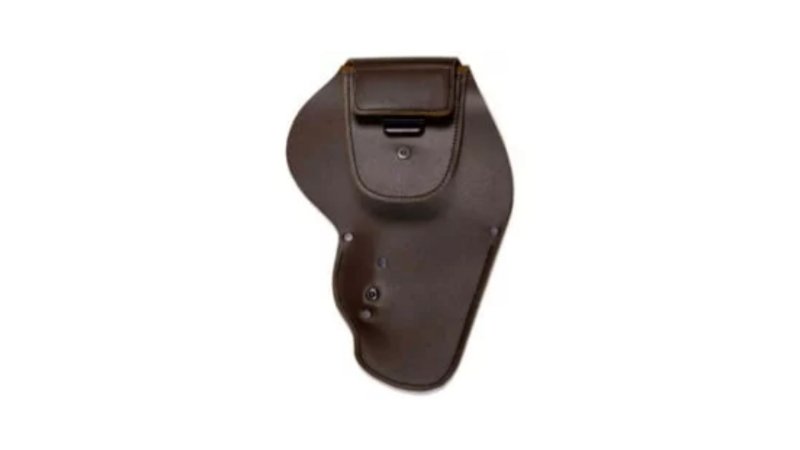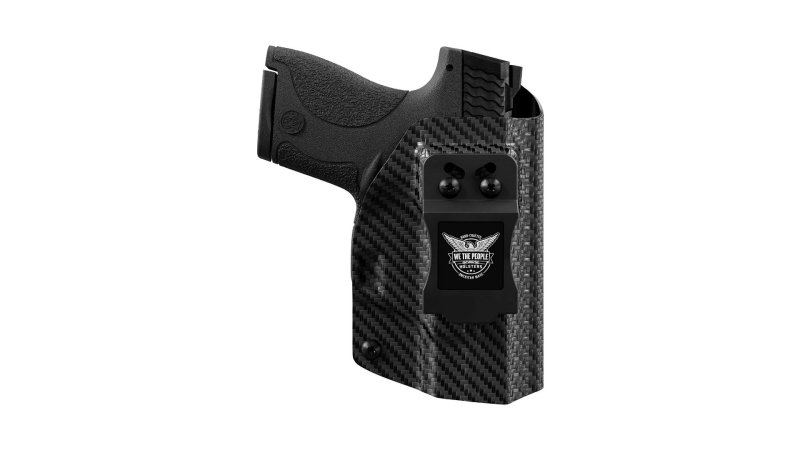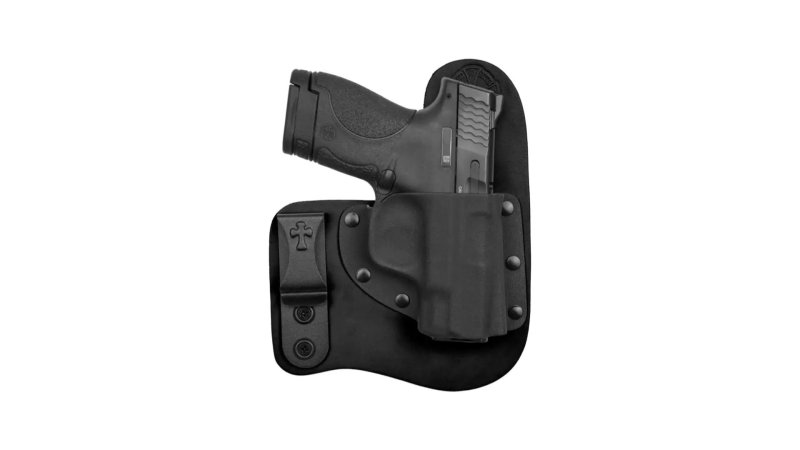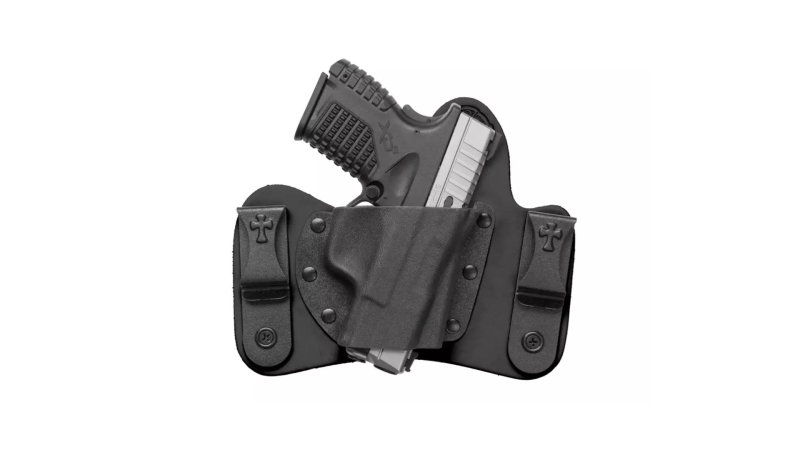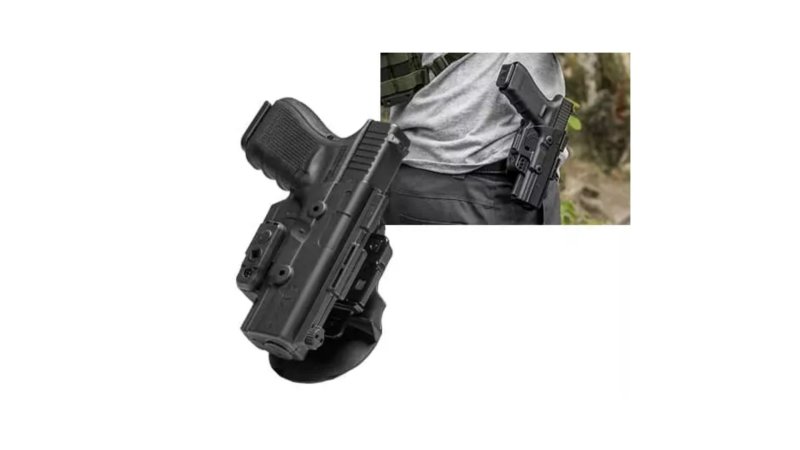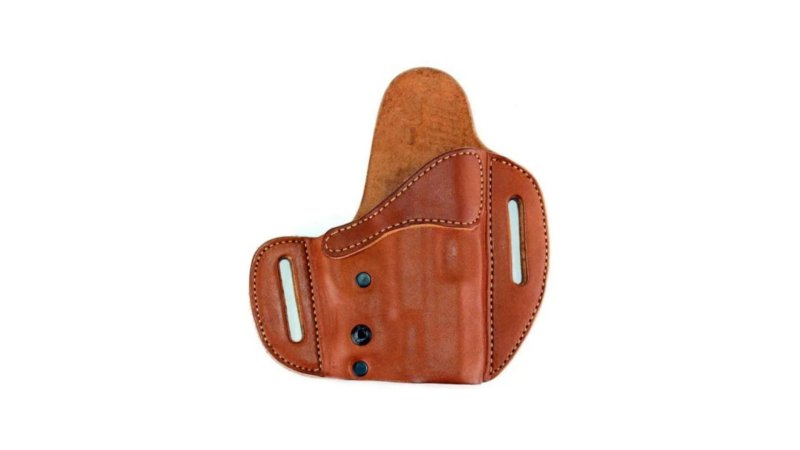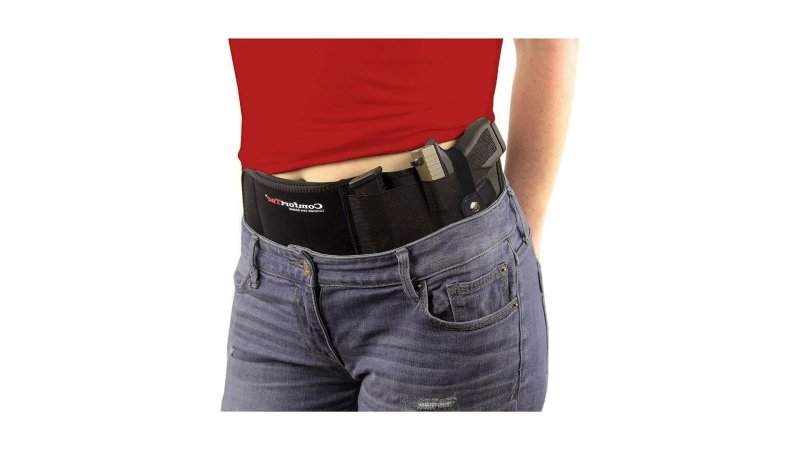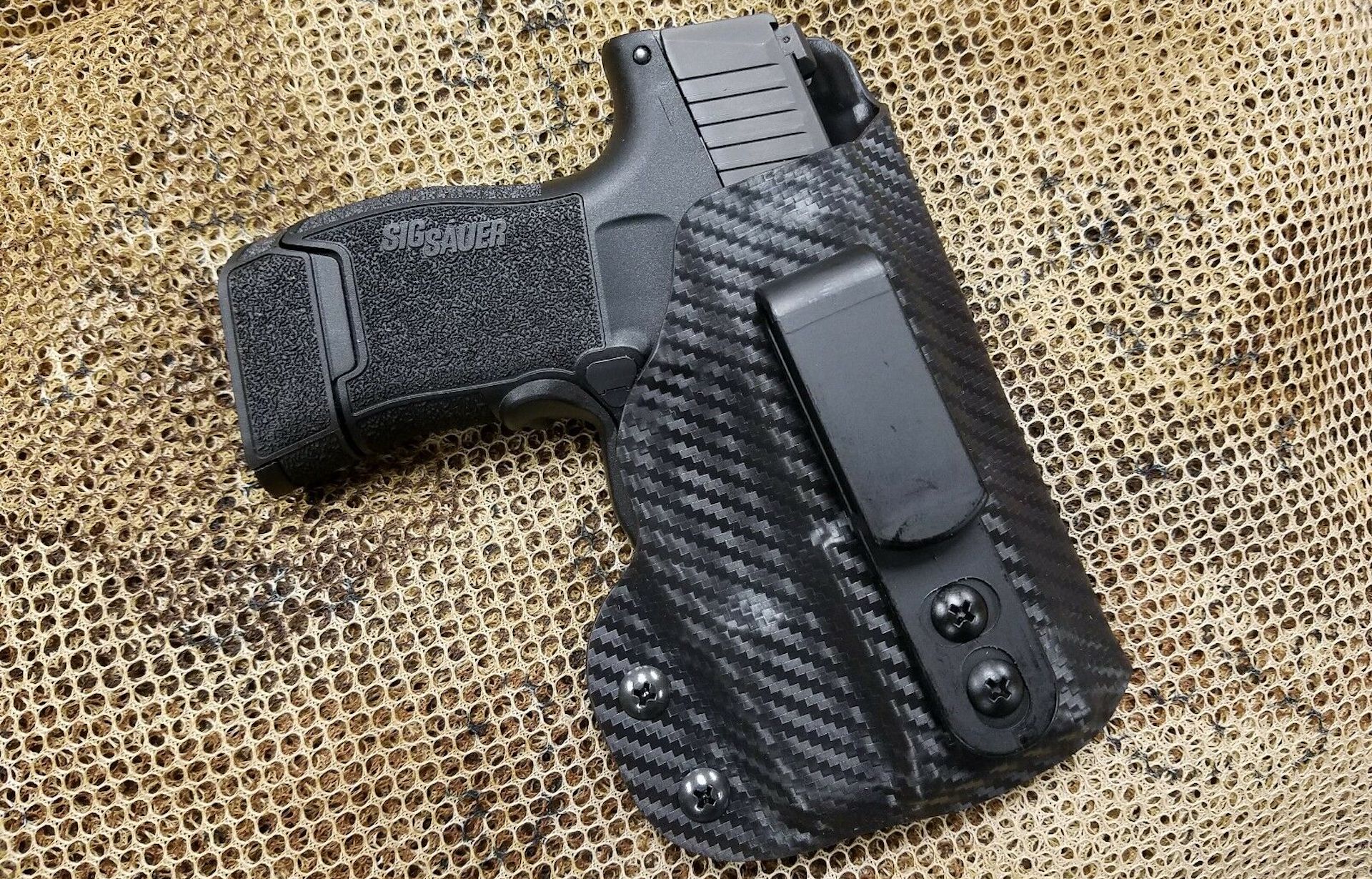

We may earn revenue from the products available on this page and participate in affiliate programs.
It says a lot about you for choosing a SIG Sauer P365 as your everyday carry gun. It means you don’t like to compromise ammo capacity for carry-ability. You value reliability. You’re well-dressed, have great hair, and like long, armed walks on the beach — okay, I’m just guessing about that last part. Now you’re looking for the best P365 holster. You’re in luck, because we can help you.
In this article, we’ll help you choose the best SIG P365 holsters for any occasion based on our personal experience with the firearm. Read on to find out about the best SIG P365 holsters for you.
- Best Overall: Urban Carry G3
- Best Value: We The People AIWB
- Honorable Mention: Crossbreed Freedom Carry IWB
- Best IWB: Crossbreed MiniTuck
- Best OWB: Alien Gear Shapeshift OWB Paddle Holster
- Best Leather: Urban Carry LockLeather OWB
- Best for Women: ComfortTac Ultimate Belly Band Holster
Methodology
How did we decide which holsters were worthy of your hard-earned cash? For this article, the main source we drew from was personal experience. I carry concealed more days than not, I’ve used holsters of myriad designs and materials, and I’ve spent a lot of time carrying in all of the most common carry positions, so these experiences inform the picks in this article.
For particular holsters or brands that we haven’t had first-hand experience with, we did a deep dive into the manufacturer’s websites to glean detailed information to determine the best holster for the SIG P365. Because the P365 is specifically designed for CCW, we focus on SIG P365 concealed-carry holsters more than other styles. Lastly, we crowdsourced reviews and included only the most consistently highly-rated contenders. Below is a list of criteria used to determine the winners.
- Comfort: Given that the P365 is specifically designed for EDC, and the number one am-I-going-to-carry-today factor for most folks is comfort, this aspect was given the most weight when determining top contenders.
- Concealability: After comfort, the next most important factor for a CCW holster is concealability. Granted, most of us aren’t going on deep-cover missions to places we can’t say we went, but even for the suburban grocery store run, we don’t want a Karen sounding the alarm that we have a gun in aisle five because, although we’re not in the wrong, no one wants to deal with a Karen.
- Price: For all but the one percent, value for the dollar is an ever-present consideration.
- Draw speed: “This guy’s an idiot, he put draw speed at number four when it should be number one.” See number one. As much as we’d all like to think that when the day comes, we’ll out-draw the bad guy like a scene from Maverick, in reality, what really matters is: Do you have your CCW gun or not?
- Build quality/material: Thickness of kydex/leather? Rivets vs screws? Belt clip material?
- Extra features: Light/laser/optics compatible? Color options? Patented/proprietary features?
Best Overall
Urban Carry G3
Pros
- Hands-down, the most comfortable CCW holster I’ve ever used
- Extremely concealable
- Slick website holster customization tool
Cons
- Slower draw time than typical CCW holster
- Reloading from optional extra mag holster is cumbersome
Product Specs
- Material: Supple leather, brown or black, either saddle grade (standard) or English bridle (premium)
- Retention: Urban Carry’s Lock Leather clip passively grabs the leading edge of the trigger guard. If a light or laser is used, retention is achieved with a strong magnet sewn into the holster.
- Carry position: Appendix below-the-waistband (BWB)
- Belt clip: Coated spring steel
- Light/laser/optics compatible: Yes
- Extra mag option: Yes
- Special features: This holster rides entirely below the waistband and your gun is secured either with Urban Carry’s Lock Leather hybrid clip, or a strong magnet depending on gun configuration.
Best Value
We The People AIWB
Pros
- For the money, a feature-packed holster
- Highly adjustable for ride height/cant, carry position
- Open muzzle, compatible with threaded barrels
Cons
- Not light/laser compatible
- 100% Kydex is often not optimal for all day carry comfort
Product Specs
- Material: 0.08 inch Kydex, multiple color/pattern options
- Retention: Molded detent passively grabs the trigger guard with an audible click
- Carry position: Each holster is user-modifiable for multiple carry positions, ride heights, and cants.
- Light/laser/optics compatible: RDS version available for optics, no light/laser option
- Extra mag option: No
- Specia features: Highly adjustable for ride height, cant, and carry position / optional holster claw for max concealability
Honorable Mention
Crossbreed Freedom Carry IWB
Pros
- Designed to be compatible with most carry positions
- Very easy on/off, single belt clip deSIGn
- Premium powder-coated spring steel belt clips with multiple clip styles
- Lifetime warranty
Cons
- Not as stable as a two-belt clip holster
- Not typically the most comfortable style for all-day carry
Product Specs
- Material: Leather/Kydex hybrid / Crossbreed offers three leather grades and several Kydex colors
- Retention: Hybrid holsters rely on pressure from your body on the leather and a passive friction/click fit against the Kydex
- Carry position: Ideal for appendix in the waistband (AIWB) but will accommodate many carry positions
- Belt clip: Premium, powder-coated medium-gauge spring steel
- Light/laser/optics compatible: Yes to all three
- Extra mag option: No, but Crossbreed does offer holsters with paired mag carriers and stand-alone mag carriers
- Special features: Three leather grades and several Kydex colors to choose from
Best IWB
Crossbreed MiniTuck
Pros
- Specifically designed for strong-side carry of sub-and-compact pistols
- Award-winning comfort for an IWB holster
- Premium powder-coated spring steel belt clips with multiple clip styles
- Lifetime warranty and try-it-free for two weeks
Cons
- More expensive than many IWB carry options
- No integrated extra mag option (stand-alone mag carriers available)
Product Specs
- Material: Leather/Kydex hybrid / Crossbreed offers three leather grades and several Kydex colors.
- Retention: Hybrid holsters rely on pressure from your body on the leather and a passive friction/click fit against the kydex.
- Carry position: Strong side in the waistband (IWB)
- Belt clip: Premium, powder-coated medium-gauge spring steel
- Light/laser/optics compatible: Yes
- Extra mag option: No, but Crossbreed does offer holsters with paired mag carriers and stand-alone mag carriers.
- Special features: Adjustable for ride height and cant, try-it-free for two weeks
Best OWB
Alien Gear Shapeshift OWB Paddle Holster
Pros
- Part of a larger ecosystem of modular holster by Alien Gear
- One of few OWB P365 holsters with active retention option
- Made in America
- “Forever” warranty with 30-day “test drive”
Cons
- Twist-off paddle lacks security
Product Specs
- Material: “Superior” polymer throughout
- Retention: Active retention actuated with thumb release, or passive retention
- Carry position: Outside the waistband (OWB) strong-side paddle
- Belt clip: Polymer paddle
- Light/laser/optics compatible: No
- Extra mag option: No
- Special features: Choose between active retention with thumb release or passive retention
Best Leather
Urban Carry LockLeather OWB
Pros
- Comfort and aesthetics of leather with the passive retention of Kydex
- Given the unique benefits of the holster, retails at a reasonable price
Cons
- Not adjustable for ride height/cant/retention
- Currently no optics/light/laser compatibility (coming soon per Urban Carry’s website)
Product Specs
- Material: “Premium” leather per Urban Carry’s website
- Retention: Urban Carry’s LockLeather clip passively grabs the leading edge of the trigger guard
- Carry position: Outside the waistband (OWB) strong side or cross draw
- Belt clip: Leather slide belt
- Light/laser/optics compatible: Not currently, but per Urban Carry’s website, these options are coming soon
- Extra mag option: Yes
- Special features: Your gun is secured with Urban Carry’s Lock Leather hybrid clip inside this leather holster.
Best for Women
ComfortTac Ultimate Belly Band Holster
Pros
- Can be worn regardless of attire
- Extremely concealable
- Breathable neoprene construction
Cons
- Much slower draw time than a typical CCW holster
- Constriction of the band takes some getting used to
Product Specs
- Material: Neoprene
- Retention: Elastic strap with snap button
- Carry position: Can be worn at any level between the belly and upper torso
- Light/laser/optics compatible: To an extent
- Extra mag option: Yes
- Special features: Extra pouch for small items, knives, etc.
Our verdict on the best holsters for the SIG P365
For those who value all-day-everyday comfort and 007 concealability, the Urban Carry G3 is the holster for you. If you’re on a budget and need a solid CCW holster, look no further than the We The People AIWB. And, if you want a quality holster that boasts ease of use over all else, consider the Crossbreed Freedom Carry IWB.
Don’t agree? Did I ruffle some feathers with my picks? Let me know in the comments below.
What to consider when buying a SIG P365 holster
When shopping for a holster, understanding the general types is key. The type of holster is determined by the situation the holster will be used in (concealed carry, open carry, etc.) as well as where the holster is on your body (appendix, below the waistband, outside the waistband, etc.). Once you know what type of holster you need, the next consideration is the features incorporated into the holster (materials, compatibility with gun accessories, retention).
Types of SIG P365 holsters
Outside the waistband (OWB)
OWB means the gun is outside of, or hanging from, your belt. OWB-carry offers comfort over any other consideration. The grip and muzzle aren’t nestled next to your spare tire and/or nethers and therefore can’t jostle/pinch/prod them. OWB-carry also enables the fastest draw times as you’re typically not having to sweep away your No Step on Snek t-shirt to access your freedom seed planter. However, the trade-off for that comfort and Billy the Kid draw speed is highly reduced concealability. As the gun is outside of your pants and belt, it is much more difficult to keep it concealed from the prying eyes of Karens everywhere. Lastly, your carry positions are somewhat limited with OWB-carry compared to IWB.
Inside the waistband (IWB)
IWB means the gun is tucked between your belt and you. IWB-carry values concealability over comfort and draw speed. Your gun, depending on carry position, is either nestled up against your love handles or your nethers, which makes it less likely to be spotted by a casual observer, but more likely to make you curse that crème-filled long john you just had as the grip chafes your “little bit extra” around the midsection.
Appendix IWB (AIWB, sometimes considered its own category) eliminates the love handle problem, but introduces the baby bump/family jewels problem. For those who do carry IWB, appendix seems to be slowly taking over as the preferred carry position due to better concealability and more natural draw stroke. If you do choose to carry IWB, please commit to muscle memory the motions required to sweep away your outer garment and access your firearm, as that movement changes based on what you’re wearing.
Below the waistband (BWB)
A BWB holster drops the whole firearm, grip and all, below your beltline. The gun rides roughly between 11 and one o’clock. BWB is relatively new, and only a few holster makers offer this option. If you read the article above, you know that a BWB holster won my best overall on account of its above-average comfort and extreme concealability. The advantages are that the gun moves with your leg and is never pinching your muffin top, and there is no grip exposed above your beltline to betray the presence of your peacemaker. The major drawback of a BWB holster is draw speed because it requires an extra draw stroke (you have to pull almost the entire holster out of your pants and then draw the gun), but that can be partially mitigated with training and practice.
Shoulder and ankle
Shoulder carry puts the gun against or just below your pectoral muscle, with the muzzle pointing toward your deltoid. Ankle carry has the gun strapped around your ankle, either medial (inside) or lateral (outside) relative to your other leg. These two carry methods are much less common. Shoulder carry requires that a coat be worn for concealment, and ankle carry obviously requires pants, and watching someone draw from the ankle is pretty entertaining (and slow).
Key features of a SIG P365 holster
Holster material
The most common materials used to make holsters are leather, kydex or polymer, and neoprene. The 100 percent Kydex or polymer holsters are rigid, durable, weather-/water-/sweat- proof, come in OWB and IWB versions, and typically offer either active “lever press” or passive “click” retention, but are usually less comfortable than leather or neoprene holsters.
Hybrid holsters are half leather and half kydex, boasting the comfort of leather against the body with the passive retention of Kydex. Hybrids are almost exclusively found only in IWB variants and therefore offer no active retention.
The 100 percent leather holsters, with the exception of the few BWB holsters, are usually for OWB and shoulder carry uses and offer little to no retention (with the exception of Urban Carry Holsters’ LeatherLock). Neoprene is utilized mostly in belly band and ankle holsters.
Accessory compatibility
If your carry gun sports a red dot sight, a laser aiming device, or a tactical light, then it is important to make sure your holster can accommodate those attachments. Budget holsters typically have limited options to accommodate gun accessories. Most holsters that can fit a light or optics make you choose your specific accessory, by make and model, when you are building your holster on their website.
Retention
Retention asks the question: “How tight does your holster hold your gun?” By and large, most IWB holsters use passive “click” retention. This means the holster is intentionally undersized in a particular area (typically the trigger guard), making you push the gun past that point when you will hear a click indicating the pistol is held in place.
Passive retention protects against tumbles and hanging upside down (what, that never happens to you guys?) but not against bad guys trying to take your gun. Active retention mechanically locks your pistol into the holster until you press a button or lever to release it. Most 100 percent leather holsters have no retention, meaning the gun will fall out if turned upside down.
Pricing
The simplest holsters cost less than $20. Those have been excluded from this review because they either lack trigger protection, or their construction is not sufficient to withstand daily use. A basic Kydex or polymer holster that meets minimum safety and durability criteria will set you back about $40. If you want light/laser/optics compatibility and leather components, you’re looking at around $70 for good quality. Premium, custom, or proprietary holsters can cost more than $100.
Tips and tricks
As with something you do for decades upon decades, you pick up a few tips and tricks along the way in terms of selecting the right product, and/or using it. That’s the case with us and the best holsters for the SIG P365. To help you bridge the information gap, here’s a selection of what we’ve learned along the way.
- Make sure your holster has a good return policy. Finding the right holster for you can take some trial and error, and the best brands have a 14- to 30-day trial period with free returns.
- Find a gun shop with knowledgeable staff, ideally who will let you pick their brain about which holster might be best for your intended use, and try on various holsters in the store.
- Once you get a holster you like, don’t be afraid to modify it (depending on your level of handyman-ness) to make it even better. Punch a hole in the Kydex to adjust a belt clip. Trim some leather to fine-tune the fit.
- Consider getting a small kit with rubber grommets, washers, T-nuts, and bolts to replace worn hardware, put on different belt clips, or further modify your holster to your liking.
FAQs about SIG P365 holsters
You’ve got questions, Task & Purpose has answers.
Q: What is the difference between the P365 and the P365 SAS?
A: The SAS (SIG Anti-Snag) is a streamlined, no-snag version of the P365. Most notably, the front sight is completely absent, replaced with a fiber optic/tritium sight mounted flush in the rear of the slide. The goal is to prevent the gun from catching on anything during the draw. The downside is that the lack of a front sight reduces accuracy and, therefore, the effective range of the pistol.
Q: Can you ankle-carry a SIG P365?
A: Yes, you can, and there are several ankle holsters available. Most ankle holsters are not pistol-specific, but rather they’re made of leather or neoprene and are either one-size-fits-most or require you to order a specific holster size (but not specific to a particular pistol). See above for limitations of ankle holsters.
Q: Can you put a red dot on a SIG P365?
A: Absotively! Wait — posolutely! SIG makes the P365 X and the P365 Romeo Zero. The X comes with a removable plate that reveals a red dot mounting location, and the Romeo Zero comes with the SIG red dot sight of the same name pre-installed.
Q: What is appendix carry?
A: When you’re appendix-carrying, you have an IWB holster positioned between roughly 11- and one-o’clock if 12 o’clock is your belly button. Appendix-carry boasts excellent concealability and a more natural draw stroke than strong-side carry, but most will agree that it is somewhat less comfortable as you’re either getting poked in the family jewels or thigh by the muzzle, or your baby bump is rubbing on/getting violated by the grip.
